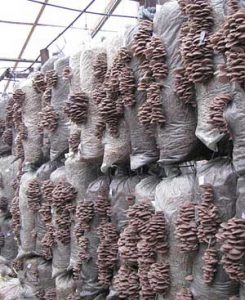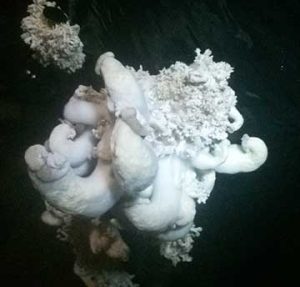
Let’s keep it simple: no light — no mushrooms.
If you leave your mushroom blocks in complete darkness, nothing good will happen. Instead of mushrooms, you’ll get a thin stem growing from the primordia — like a little needle with a black dot on the end. No cap, no cluster, no harvest.
✅So yes, oyster mushrooms do need light to grow.
Table of Contents
Mushroom growers don’t always agree on this one.
Some turn on the lights for 12 hours a day. Others just follow the natural day length — sunrise to sunset. Some rooms are lit up like a photography studio. Others get by with a few dim lamps.
Here’s the thing: 24/7 lighting doesn’t make sense — not for your power bill, and not for the mushrooms. Oyster mushrooms evolved in nature, and in nature it gets dark every night.
The real problem with poor lighting isn't that the mushroom won’t grow at all — it’s that it grows weird. The stem stretches out toward the nearest light source, trying to find it.
But don’t worry — you don’t need anything fancy.
✅Even soft, diffused light is enough to form normal-looking mushrooms.
If your mushrooms have long stems even with proper lighting, excess CO₂ is likely the cause.
📌Here’s how to recognize and fix it →

Oyster mushrooms love diffused natural light.
When they grow this way, you get beautiful, dense clusters with almost no stem. The caps are fleshy and full, usually a rich brown or gray-brown.
And they’re much more resilient to small changes in temperature, humidity, or even CO₂ levels.
✅Just be careful — no direct sunlight.
A sunbeam on the cap can leave a burn. If you have windows, shade them. You can use a thin layer of lime wash or just put up a small awning.
💡 Tip: if you have a growing room with windows, cover them with black plastic during the incubation stage.
Even though many growers say light doesn’t affect incubation, I’ve noticed blocks grow more slowly and unevenly if there’s too much light.

Like I said earlier — without light, oyster mushrooms don’t grow properly.
I’m not sure about other mushroom species, but for oysters, this is a hard yes. You need to turn on the lights once the first primordia show up.
The photo on the right shows what happens when there’s no light and no ventilation — not pretty.
Here’s a little story from my own experience.
We had two growing rooms, each about 8×25 meters (26×82 ft). One had five 30W energy-saving white bulbs along a central aisle. The other had just one bulb in the center.
Guess what? No real difference. The mushrooms looked the same — same color, same size, same stem length.
That one lamp was installed high up (about 3.5 meters/11 ft) and lit the whole room just fine. Plus, a small gap along the ceiling let in a bit of daylight from outside.
✅One funny thing we noticed: mushrooms grow fast around dawn.
Workers would harvest at night, and by the time I came in the morning, new clusters had already popped up. Eventually, we started turning on the lights from 5 AM to noon — and that worked great for us.
What’s the “right” amount of light? It depends.
Some strains might respond differently. And every grower has their own preferences. I usually recommend experimenting to find what works best for you.
💡Try one of these approaches:
See what your mushrooms like best.
Yes, they do. Most growers use LED or energy-saving light bulbs now.
What lamps are needed for growing oyster mushrooms?
You only need about 100 to 150 lumens per square meter (10–15 lumens per square foot). Just check the lumen rating on the bulb packaging — it’s usually printed right there.
That’s roughly one LED bulb for every 15–20 square meters (160–215 sq ft).
White or yellow light? I haven’t noticed a big difference. But some growers say white light is better.
One grower even told me he puts a thin plastic bag between the bulb and socket to protect it from moisture — and says the color shift helps mushrooms grow. I’ve never tried it and honestly doubt it makes a big difference, but feel free to experiment.
In the past, growers used mercury lamps, but today LED lights are the most efficient and accessible option.
💡 Do you need special grow lights for oyster mushrooms?
No, it's not necessary.
Unlike plants, mushrooms don’t rely on light for photosynthesis. They use light as a signal to start fruiting, but they don’t depend on a specific spectrum for growth like plants do. So regular white LED bulbs work just fine.
There’s no need to spend money on purple grow lights or specialized LED strips — they won’t give mushrooms any extra benefits.
The most important thing is that your lights are moisture-resistant (or well protected), because the air in the grow room is usually very humid. Regular bulbs can corrode or stop working quickly if they get wet.
However, if you're curious to test different types of lighting, you can use the experiment method described in the next section.👇
Some people online claim that blue light improves yield and helps prevent disease.
If you’re curious, run your own test. Take one batch of blocks (for example, 60 blocks), split it in half. Grow one half under regular white light, the other under blue light — and track the yields carefully.
Be sure to label everything clearly and weigh all the mushrooms from each group separately. Then compare:
And repeat the test a few times — at least three full cycles. If the blue light consistently gives you better yields, go ahead and switch to it.
